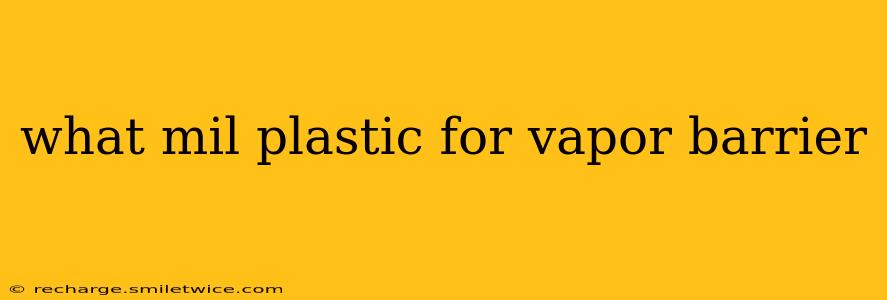What Mil Plastic for Vapor Barrier? Choosing the Right Mil Thickness for Your Vapor Barrier
Selecting the appropriate mil thickness for your vapor barrier is crucial for protecting your building's structure and ensuring a healthy indoor environment. The "mil" refers to the thickness of the plastic sheeting, measured in thousandths of an inch (1 mil = 0.001 inches). There's no single "best" mil thickness; the ideal choice depends heavily on the specific application and climate. This guide will help you navigate the complexities of choosing the right mil plastic for your vapor barrier needs.
What is a Vapor Barrier and Why is it Important?
Before diving into mil thicknesses, let's establish the importance of a vapor barrier. A vapor barrier is a layer of material designed to prevent moisture vapor from passing through a building's structure. Moisture can lead to a host of problems, including:
- Mold and mildew growth: Excess moisture creates ideal conditions for mold and mildew, which can cause respiratory problems and damage building materials.
- Rot and decay: Wood and other organic materials are susceptible to rot and decay in the presence of moisture.
- Insulation degradation: Moisture can reduce the effectiveness of insulation, leading to higher energy bills.
- Structural damage: Prolonged exposure to moisture can weaken the structural integrity of a building.
A properly installed vapor barrier is essential for preventing these problems and maintaining a comfortable, healthy living space.
What Mil Thickness of Plastic Should I Use for a Vapor Barrier?
The ideal mil thickness for a vapor barrier depends on several factors:
- Climate: In humid climates, a thicker vapor barrier might be necessary to prevent excessive moisture penetration. In drier climates, a thinner barrier may suffice.
- Application: The location and intended use of the vapor barrier influence the required strength and durability. A vapor barrier in a crawl space might require a thicker material than one used in a wall cavity.
- Expected stress: The potential for physical damage or puncture should be considered when selecting mil thickness. Areas prone to foot traffic or potential damage may need a thicker, more resilient material.
Common mil thicknesses and their applications:
- 4-6 mil: Often used for temporary applications, such as protecting materials during construction. Generally not recommended as a permanent vapor barrier due to its low durability and permeability.
- 6-10 mil: Suitable for some applications, but might not offer sufficient protection in humid climates or high-stress areas.
- 10 mil and above: Provides better protection against moisture and is more durable. This is generally recommended for most permanent vapor barrier applications. You'll often find 10 mil, 12 mil, or even 20 mil plastic used for this purpose.
Important Note: While thicker plastic generally offers better protection, it's crucial to remember that the installation of the vapor barrier is just as important as its thickness. Proper sealing and overlapping are essential for preventing moisture leaks.
What are the Different Types of Vapor Barrier Plastics?
While mil thickness is important, the type of plastic also matters. Some common types include:
- Polyethylene (PE): A common and relatively inexpensive material often used for vapor barriers.
- Visqueen: A brand name often associated with polyethylene sheeting used for vapor barriers. (Note: Visqueen is not the only manufacturer of suitable vapor barrier sheeting.)
Is 6 Mil Plastic Enough for a Vapor Barrier?
While 6-mil plastic might be suitable for some temporary applications or in very dry climates, it's generally not recommended as a permanent vapor barrier, especially in humid regions. Thicker options (10 mil and above) offer better protection and durability.
What is the Best Vapor Barrier Material?
There isn't one single "best" vapor barrier material. The optimal choice depends on the specific application and climate. However, thicker polyethylene sheeting (10 mil and above) is often a cost-effective and reliable option for many applications. Always consult with a building professional to determine the best material for your specific needs.
This information should help you make an informed decision when selecting the appropriate mil plastic for your vapor barrier needs. Remember to consult with building professionals for personalized advice based on your specific project and location. This ensures optimal protection and prevents potential future problems.
